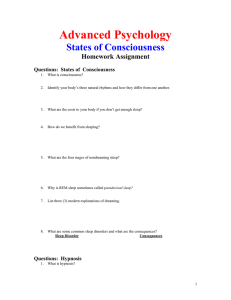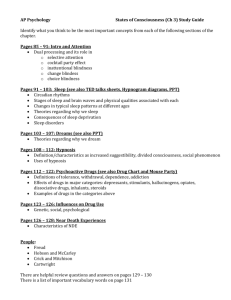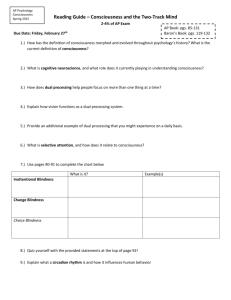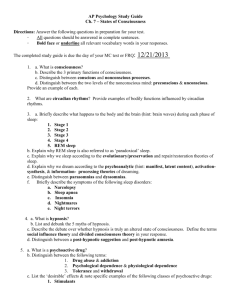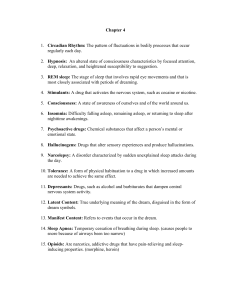chapter 5 Consciousness ppt
advertisement
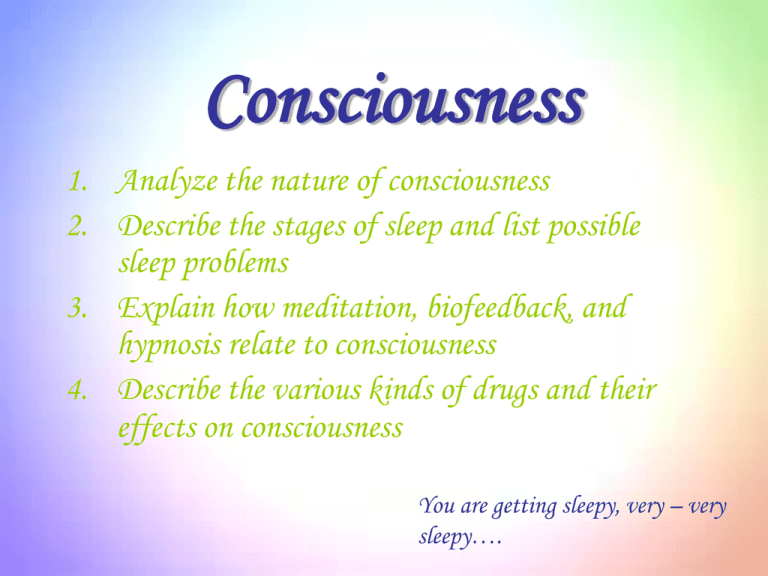
Consciousness 1. Analyze the nature of consciousness 2. Describe the stages of sleep and list possible sleep problems 3. Explain how meditation, biofeedback, and hypnosis relate to consciousness 4. Describe the various kinds of drugs and their effects on consciousness You are getting sleepy, very – very sleepy…. Levels of Consciousness The Study of Consciousness • Psychologists have not always thought that consciousness should be part of the study of psychology. In 1904, William James wrote an article called “Does consciousness Exist?” In this article, James questioned the value of studying consciousness because he could not think of a scientific way to observe or measure another person’s consciousness. His point was that even though we can see other people talking or moving around, we cannot actually measure their consciousness. Consciousness as a Construct • Construct is something that you cannot see or touch, but it is measured through other behaviors. • Consciousness can be studied many believe because it can be linked with measurable behaviors Meaning of Consciousness • Consciousness as Sensory Awareness – Your senses allow you to be aware of the things around you • Consciousness as Direct Inner Awareness – You do not hear, see, smell, or touch thoughts, images, emotions, or memories – yet you are still conscious of them • Consciousness as Sense if Self – Being aware of yourself as a unique individual separate from the world around you Levels of Consciousness • The Preconscious Level – Not in your immediate awareness but by directing your attention towards it you can bring it to your consciousness • The Unconscious Level/Subconscious Level – Level of awareness that remains hidden because you want to block it out • The Nonconscious Level – Controls biological functions Quick Quiz 1 1. Explain what is meant by a psychological construct. 2. List and describe three levels of consciousness at which awareness is limited. 3. CRITICAL THINKING: Do you think that a person can study or understand the consciousness of another person? Why or why not? Sleep and Dreams • Much of how people, animals, and even plants function is governed by circadian rhythms. The human circadian rhythms usually operate on a 24hour day. The most studied circadian rhythm is that of the sleep-wake cycle. Because people normally associate periods of wakefulness and sleep with the rotation of the earth. The Stages of Sleep • Sleep cycles are measured by brain waves: Alpha, theta, and delta • Stage 1 – The patient is less aware of their surroundings then just a few minutes ago. They may waken by a whisper, or noise. They are relaxed, their breathing is more regular and there is more slow, rolling eye movement noticed. The patient may also have what are know as "hypnogogic experiences" dream-like sensations of falling, hearing voices, or seeing flashes of pictures. – It takes 5 – 10 minutes to progress to Stage 2. Stage 1 accounts for only about 5% of the total sleep time. – Brain waves slow down from alpha to theta • Stage 2 – Stage two is the first stage of true sleep and accounts for about 50% of total sleep. The patient is even less aware of their surroundings and is characterized by as light sleep since individuals are easily aroused from this sleep state. – Stage 1 & 2 are “transitional” stages of sleep. It takes approximately 30 minutes to complete these stages and enter Stage 3. • Stages 3 & 4 – Stages 3 & 4 are also referred as “SLOW WAVE SLEEP”. – As the patient is in a very relaxed state, they have a slow, regular heartbeat and respiratory rate. Their muscles are very relaxed. It is very difficult to arouse a patient in “Slow Wave Sleep”. If they are awakened, they are confused and slow to react. It is normally easy for they to go back to sleep. • After perhaps half an hour of stage 4 sleep, we begin a relatively quick journey back to stage 3 to stage 2 to stage 1, finally we enter the REM (Rapid Eye Movement) stage of sleep • Healthy young adults first experience REM sleep within 90 minutes of falling asleep. It recurs about every 90 minutes throughout the night and each time it recurs, we spend a little bit longer in this stage • In this stage, the patient’s eyes move in a rapid, flickering, twitching motion while their eyelids are closed. The patient is temporarily paralyzed during this stage. This temporary paralysis includes the patient’s respiratory muscles, except for the diaphragm. It has been suggested that this paralysis is a clever device that lets the mind explore the realms of its subconscious, while preventing us from acting out dream events. Blood flow to the brain is also increased during this stage of sleep Why Do We Sleep? • To revive the tired body and to build up resistance to infection • To relieve self of stress Dreams • The Freudian View – Your dreams reveal your inner wants and urges • The Biopsychological Approach – The brain fires neurons and depending on the part of the brain that it effects you dream about different things Sleep Problems • Insomnia – The inability to sleep – Occurs usual in times of high stress – Can get worst if you try to force yourself to sleep and focus on the problem • Nightmares and Night Terrors – People who are anxious or depressed are more likely to have nightmares – Nightmares are usually during REM Night terrors are usually during sleep cycles 3 & 4 • Sleepwalking – More common in children – May seem fully aware of what they are doing and answer questions then not be able to remember once they wake up • Sleep Apnea – A person stops breathing in their sleep – Some believe it is linked to SIDS • Narcolepsy – Person is totally normal one minute and in REM sleep the next – No known cause Quick Quiz 2 1. Describe the five stages of sleep. 2. Describe three kinds of sleep problems. 3. CRITICAL THINKING: Compare and contrast nightmares and night terrors. Why might it be difficult to differentiate between the two in a young child? Meditation, Biofeedback, and Hypnosis • People who are asleep and dreaming are in an altered state of consciousness. Other altered states of consciousness occur when we are awake. These states of consciousness can be achieved through meditation, biofeedback, and hypnosis Meditation: Narrowing Consciousness • Focus on a peaceful, repetitive stimuli – Flame – Pattern – Mantra • By narrowing ones consciousness you can suspend fears and worries and achieve a calmness • Often used in Religions Biofeedback: Feeding Back Information • The word "biofeedback" was coined in the late 1960s to describe laboratory procedures then being used to train experimental research subjects to alter brain activity, blood pressure, heart rate, and other bodily functions that normally are not controlled voluntarily. • Biofeedback places unusual demands on patients. They must examine their day-to-day lives to learn if they may be contributing to their own distress. They must recognize that they can, by their own efforts, remedy some physical ailments. They must commit themselves to practicing biofeedback or relaxation exercises every day. They must change bad habits, even ease up on some good ones. Most important, they must accept much of the responsibility for maintaining their own health. Hypnosis: Myths and Realities • What is Hypnosis – Some believe it is an altered state of consciousness in which people act as if they are in a trance – However studies have shown hypnotized peoples brainwaves resemble that of a woken person – Invented by Franz Mesmer in the late 1700s • How Can we Explain Hypnosis – Freud theory, we allow ourselves to revert to being childish – People believe they are playing a part • How can Hypnosis be Achieved – Focus on an object – The hypnotists voice Is Hypnosis Effective? • Hypnosis and Memory – People make mistakes under hypnosis and can recall events as well as those who are not under • Hypnosis and Pain Prevention – Used as an anesthetic • Hypnosis and Quitting Habits – Posthypnotic suggestion, imagine the habit repulses you Quick Quiz 3 1. Define meditation. 2. Explain how biofeedback works. 3. CRITICAL THINKING: Why do you think hypnosis is not used more often to relieve pain or help people change habits? Drugs and Consciousness • Drugs have a wide range of effects. Some of them slow down the nervous system. Others spur it into rapid action. Some drugs, such as alcohol and nicotine, are believed to be connected with serious diseases, including cancer and heart disease. Many drugs are addictive. Drugs also have a number of effects on consciousness. They may distort people’s perceptions, change their moods, or cause them to see or hear things that are not real. Categories of drugs that affect consciousness include depressants, stimulants, and hallucinogens. Drugs and Consciousness • Depressants – Alcohol – Narcotics • Stimulants – Nicotine – Amphetamines – Cocaine • Hallucinogens – Marijuana – LSD Treatments for Drug Abuse •Detoxification •Maintenance Programs •Counseling •Support Groups Quick Quiz 4 1. Describe the effects of depressants, stimulants, and hallucinogens. Give examples of each kind of drug. 2. CRITICAL THINKING: DO you think people use drugs to heighten consciousness or to escape from it? Explain you answer. •At the count of three you will wake-up and remember everything that was presented to you in this PowerPoint! 1…….2……..3…… The End


